Assessing Uber's Reputation and Corporate Governance Principles
VerifiedAdded on 2023/06/08
|14
|3700
|95
AI Summary
This article evaluates Uber's reputation and corporate governance principles, analyzing the incorporation of corporate governance principles and stakeholders affected by Uber Health. It also discusses the risks associated with Uber's new venture of flying cars and suggests ways to reduce failures at Uber. The article further discusses the notion that Uber is acting as a 'shaper of society' as it challenges transport and labor markets worldwide.
Contribute Materials
Your contribution can guide someone’s learning journey. Share your
documents today.
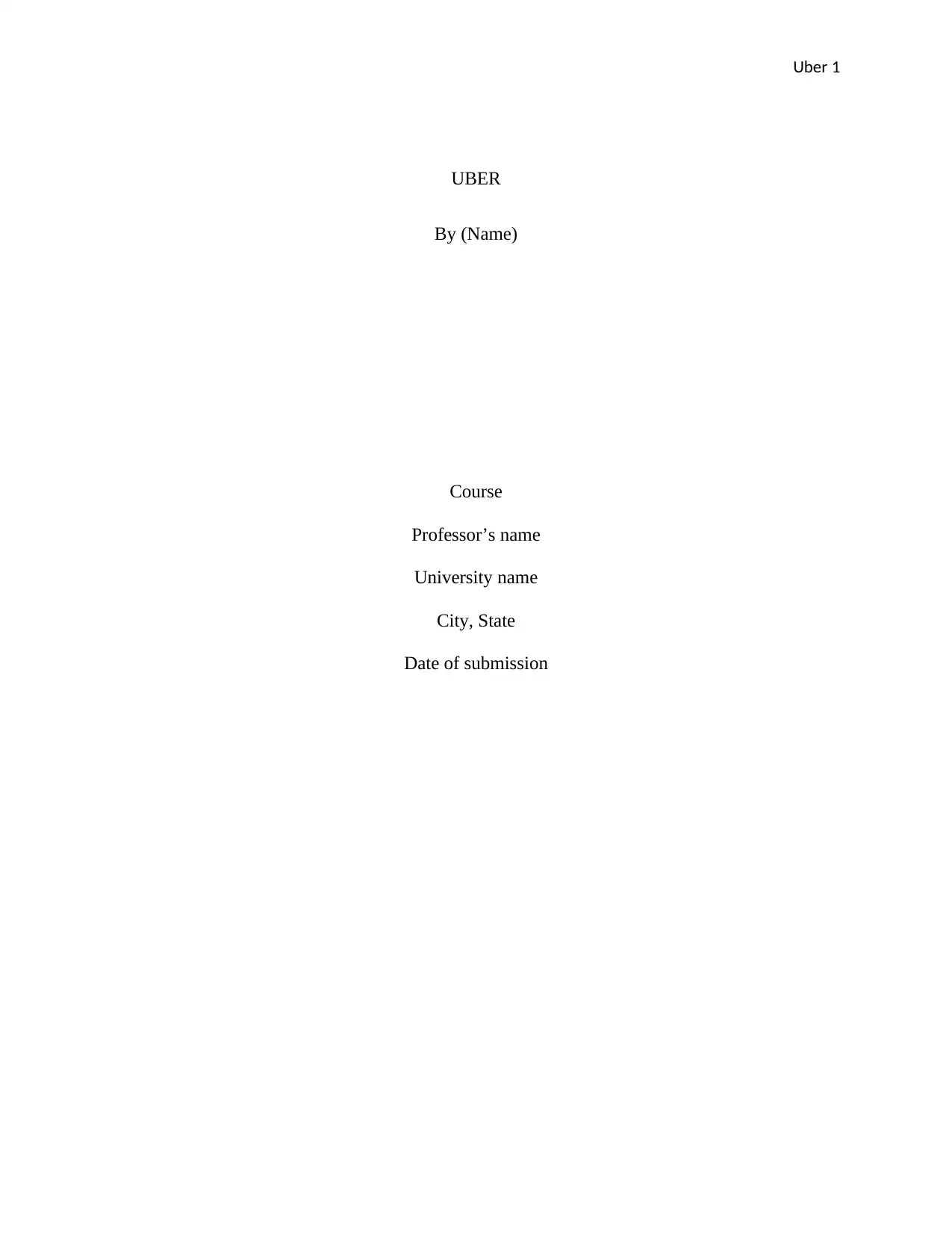
Uber 1
UBER
By (Name)
Course
Professor’s name
University name
City, State
Date of submission
UBER
By (Name)
Course
Professor’s name
University name
City, State
Date of submission
Secure Best Marks with AI Grader
Need help grading? Try our AI Grader for instant feedback on your assignments.
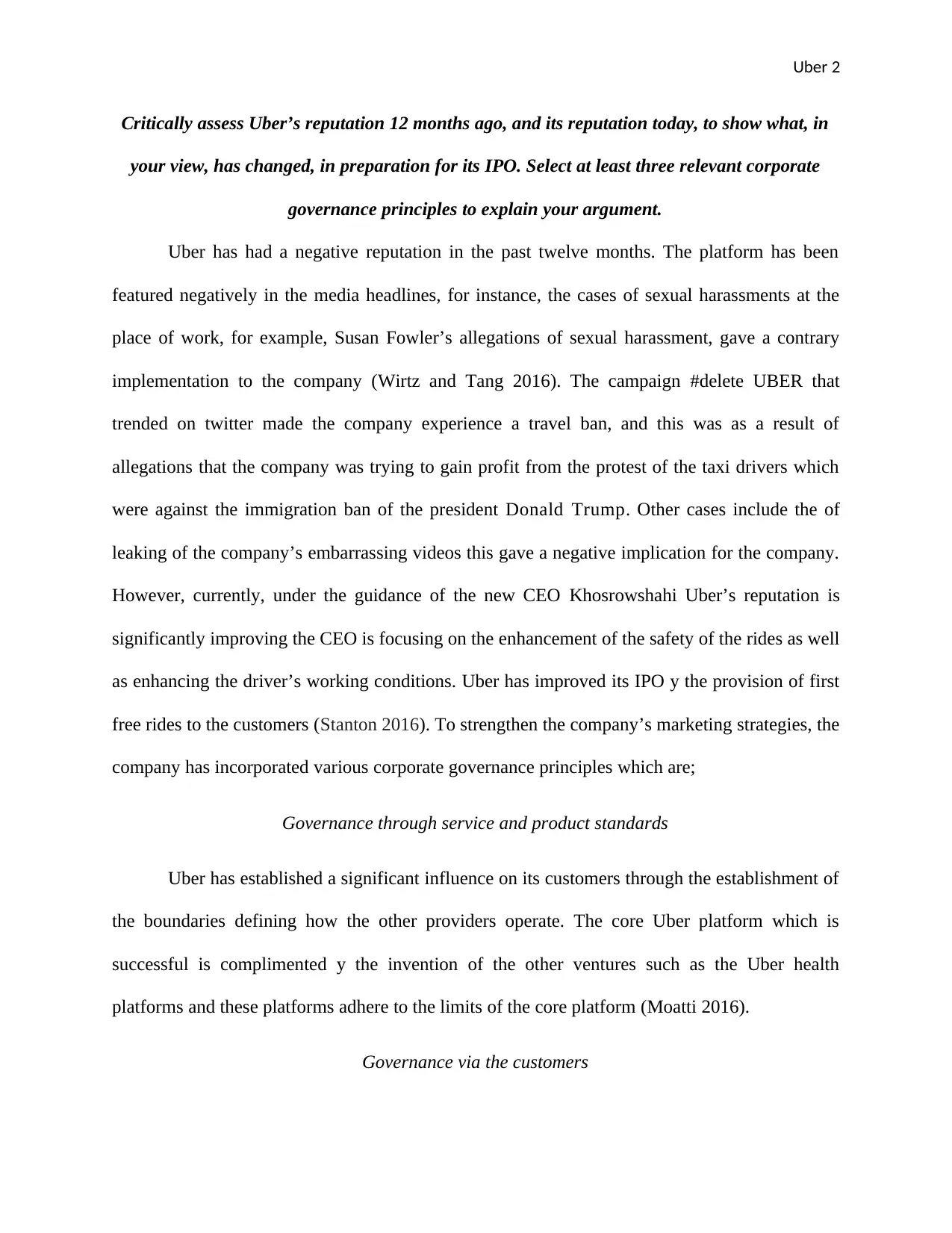
Uber 2
Critically assess Uber’s reputation 12 months ago, and its reputation today, to show what, in
your view, has changed, in preparation for its IPO. Select at least three relevant corporate
governance principles to explain your argument.
Uber has had a negative reputation in the past twelve months. The platform has been
featured negatively in the media headlines, for instance, the cases of sexual harassments at the
place of work, for example, Susan Fowler’s allegations of sexual harassment, gave a contrary
implementation to the company (Wirtz and Tang 2016). The campaign #delete UBER that
trended on twitter made the company experience a travel ban, and this was as a result of
allegations that the company was trying to gain profit from the protest of the taxi drivers which
were against the immigration ban of the president Donald Trump. Other cases include the of
leaking of the company’s embarrassing videos this gave a negative implication for the company.
However, currently, under the guidance of the new CEO Khosrowshahi Uber’s reputation is
significantly improving the CEO is focusing on the enhancement of the safety of the rides as well
as enhancing the driver’s working conditions. Uber has improved its IPO y the provision of first
free rides to the customers (Stanton 2016). To strengthen the company’s marketing strategies, the
company has incorporated various corporate governance principles which are;
Governance through service and product standards
Uber has established a significant influence on its customers through the establishment of
the boundaries defining how the other providers operate. The core Uber platform which is
successful is complimented y the invention of the other ventures such as the Uber health
platforms and these platforms adhere to the limits of the core platform (Moatti 2016).
Governance via the customers
Critically assess Uber’s reputation 12 months ago, and its reputation today, to show what, in
your view, has changed, in preparation for its IPO. Select at least three relevant corporate
governance principles to explain your argument.
Uber has had a negative reputation in the past twelve months. The platform has been
featured negatively in the media headlines, for instance, the cases of sexual harassments at the
place of work, for example, Susan Fowler’s allegations of sexual harassment, gave a contrary
implementation to the company (Wirtz and Tang 2016). The campaign #delete UBER that
trended on twitter made the company experience a travel ban, and this was as a result of
allegations that the company was trying to gain profit from the protest of the taxi drivers which
were against the immigration ban of the president Donald Trump. Other cases include the of
leaking of the company’s embarrassing videos this gave a negative implication for the company.
However, currently, under the guidance of the new CEO Khosrowshahi Uber’s reputation is
significantly improving the CEO is focusing on the enhancement of the safety of the rides as well
as enhancing the driver’s working conditions. Uber has improved its IPO y the provision of first
free rides to the customers (Stanton 2016). To strengthen the company’s marketing strategies, the
company has incorporated various corporate governance principles which are;
Governance through service and product standards
Uber has established a significant influence on its customers through the establishment of
the boundaries defining how the other providers operate. The core Uber platform which is
successful is complimented y the invention of the other ventures such as the Uber health
platforms and these platforms adhere to the limits of the core platform (Moatti 2016).
Governance via the customers
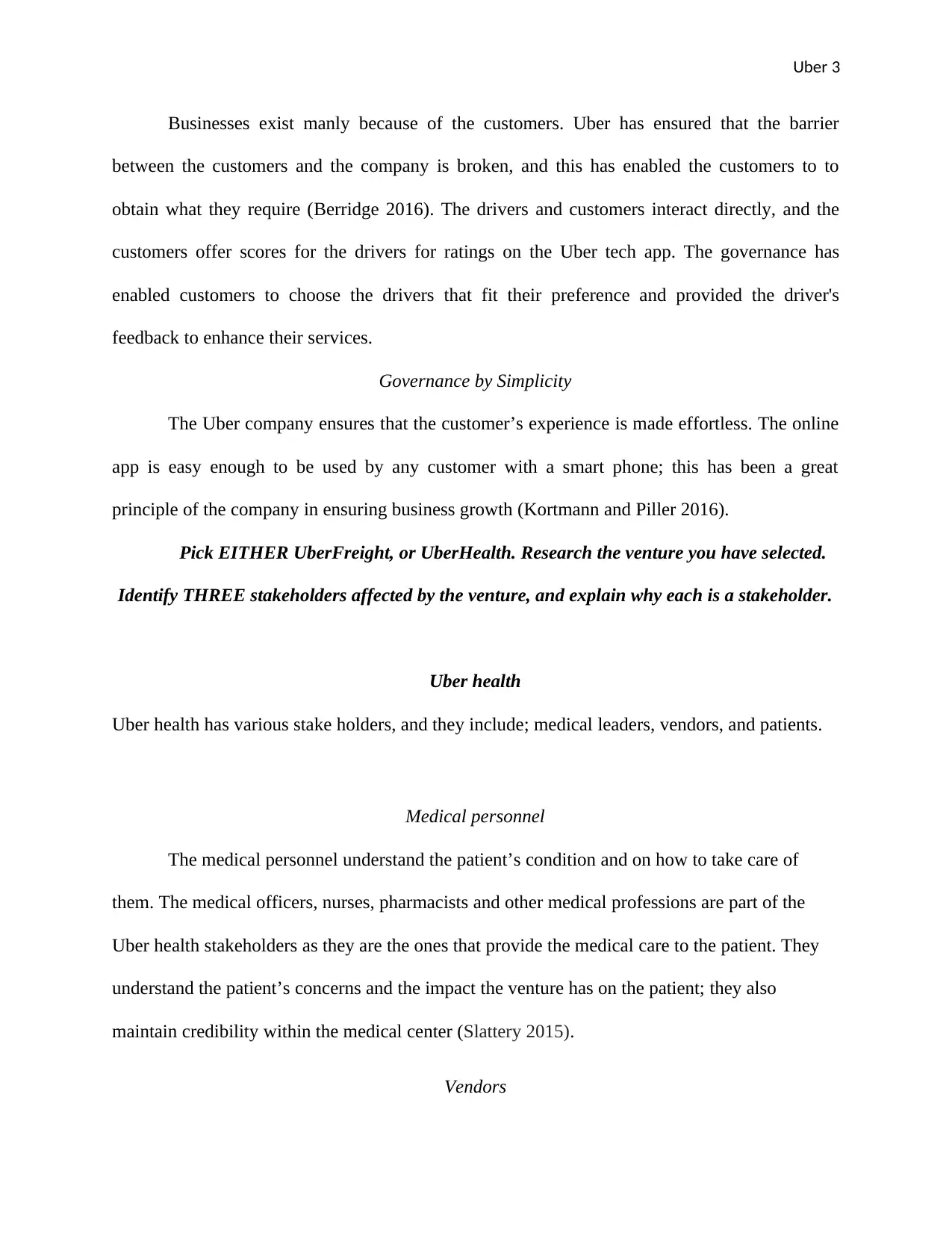
Uber 3
Businesses exist manly because of the customers. Uber has ensured that the barrier
between the customers and the company is broken, and this has enabled the customers to to
obtain what they require (Berridge 2016). The drivers and customers interact directly, and the
customers offer scores for the drivers for ratings on the Uber tech app. The governance has
enabled customers to choose the drivers that fit their preference and provided the driver's
feedback to enhance their services.
Governance by Simplicity
The Uber company ensures that the customer’s experience is made effortless. The online
app is easy enough to be used by any customer with a smart phone; this has been a great
principle of the company in ensuring business growth (Kortmann and Piller 2016).
Pick EITHER UberFreight, or UberHealth. Research the venture you have selected.
Identify THREE stakeholders affected by the venture, and explain why each is a stakeholder.
Uber health
Uber health has various stake holders, and they include; medical leaders, vendors, and patients.
Medical personnel
The medical personnel understand the patient’s condition and on how to take care of
them. The medical officers, nurses, pharmacists and other medical professions are part of the
Uber health stakeholders as they are the ones that provide the medical care to the patient. They
understand the patient’s concerns and the impact the venture has on the patient; they also
maintain credibility within the medical center (Slattery 2015).
Vendors
Businesses exist manly because of the customers. Uber has ensured that the barrier
between the customers and the company is broken, and this has enabled the customers to to
obtain what they require (Berridge 2016). The drivers and customers interact directly, and the
customers offer scores for the drivers for ratings on the Uber tech app. The governance has
enabled customers to choose the drivers that fit their preference and provided the driver's
feedback to enhance their services.
Governance by Simplicity
The Uber company ensures that the customer’s experience is made effortless. The online
app is easy enough to be used by any customer with a smart phone; this has been a great
principle of the company in ensuring business growth (Kortmann and Piller 2016).
Pick EITHER UberFreight, or UberHealth. Research the venture you have selected.
Identify THREE stakeholders affected by the venture, and explain why each is a stakeholder.
Uber health
Uber health has various stake holders, and they include; medical leaders, vendors, and patients.
Medical personnel
The medical personnel understand the patient’s condition and on how to take care of
them. The medical officers, nurses, pharmacists and other medical professions are part of the
Uber health stakeholders as they are the ones that provide the medical care to the patient. They
understand the patient’s concerns and the impact the venture has on the patient; they also
maintain credibility within the medical center (Slattery 2015).
Vendors
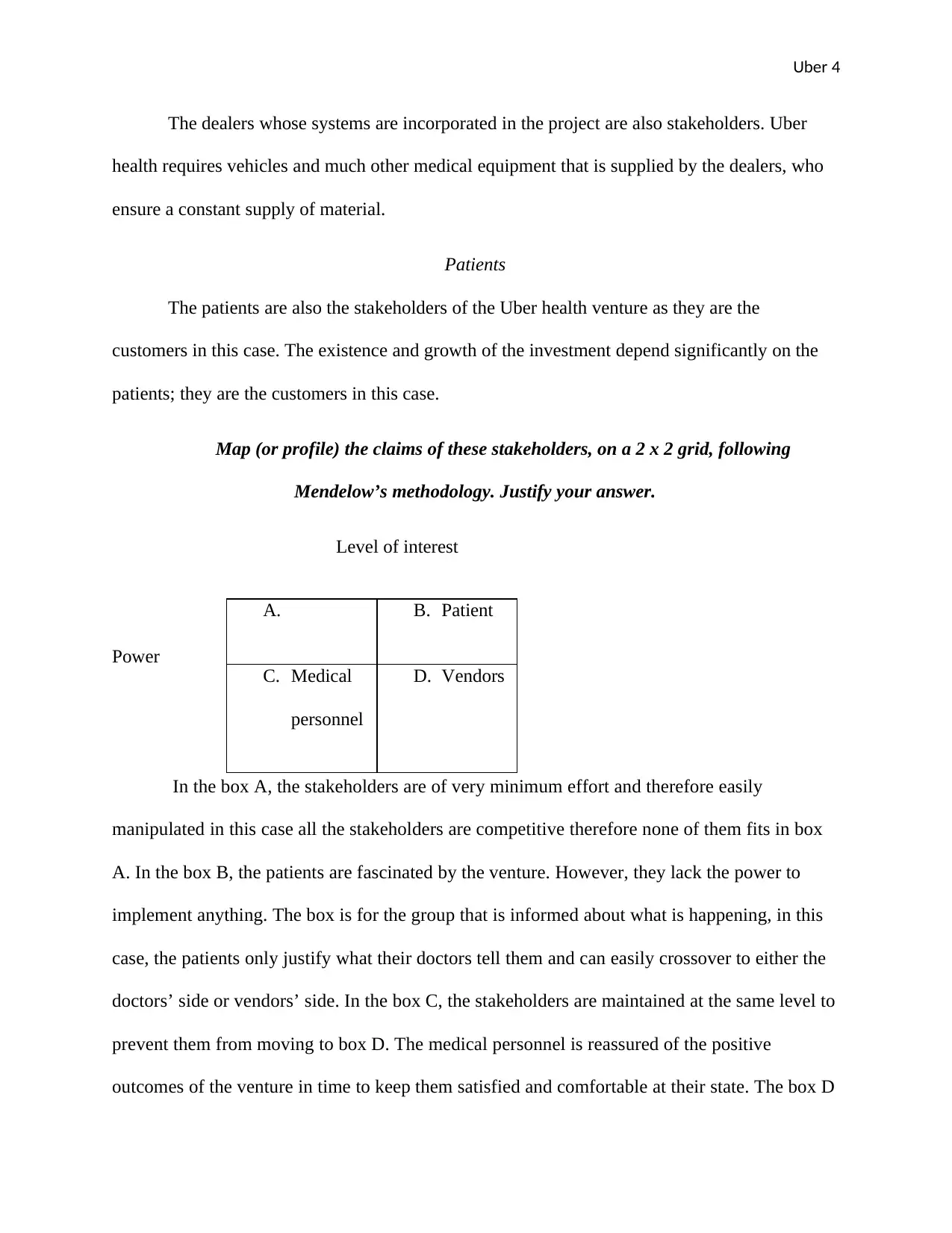
Uber 4
The dealers whose systems are incorporated in the project are also stakeholders. Uber
health requires vehicles and much other medical equipment that is supplied by the dealers, who
ensure a constant supply of material.
Patients
The patients are also the stakeholders of the Uber health venture as they are the
customers in this case. The existence and growth of the investment depend significantly on the
patients; they are the customers in this case.
Map (or profile) the claims of these stakeholders, on a 2 x 2 grid, following
Mendelow’s methodology. Justify your answer.
Level of interest
Power
In the box A, the stakeholders are of very minimum effort and therefore easily
manipulated in this case all the stakeholders are competitive therefore none of them fits in box
A. In the box B, the patients are fascinated by the venture. However, they lack the power to
implement anything. The box is for the group that is informed about what is happening, in this
case, the patients only justify what their doctors tell them and can easily crossover to either the
doctors’ side or vendors’ side. In the box C, the stakeholders are maintained at the same level to
prevent them from moving to box D. The medical personnel is reassured of the positive
outcomes of the venture in time to keep them satisfied and comfortable at their state. The box D
A. B. Patient
C. Medical
personnel
D. Vendors
The dealers whose systems are incorporated in the project are also stakeholders. Uber
health requires vehicles and much other medical equipment that is supplied by the dealers, who
ensure a constant supply of material.
Patients
The patients are also the stakeholders of the Uber health venture as they are the
customers in this case. The existence and growth of the investment depend significantly on the
patients; they are the customers in this case.
Map (or profile) the claims of these stakeholders, on a 2 x 2 grid, following
Mendelow’s methodology. Justify your answer.
Level of interest
Power
In the box A, the stakeholders are of very minimum effort and therefore easily
manipulated in this case all the stakeholders are competitive therefore none of them fits in box
A. In the box B, the patients are fascinated by the venture. However, they lack the power to
implement anything. The box is for the group that is informed about what is happening, in this
case, the patients only justify what their doctors tell them and can easily crossover to either the
doctors’ side or vendors’ side. In the box C, the stakeholders are maintained at the same level to
prevent them from moving to box D. The medical personnel is reassured of the positive
outcomes of the venture in time to keep them satisfied and comfortable at their state. The box D
A. B. Patient
C. Medical
personnel
D. Vendors
Secure Best Marks with AI Grader
Need help grading? Try our AI Grader for instant feedback on your assignments.
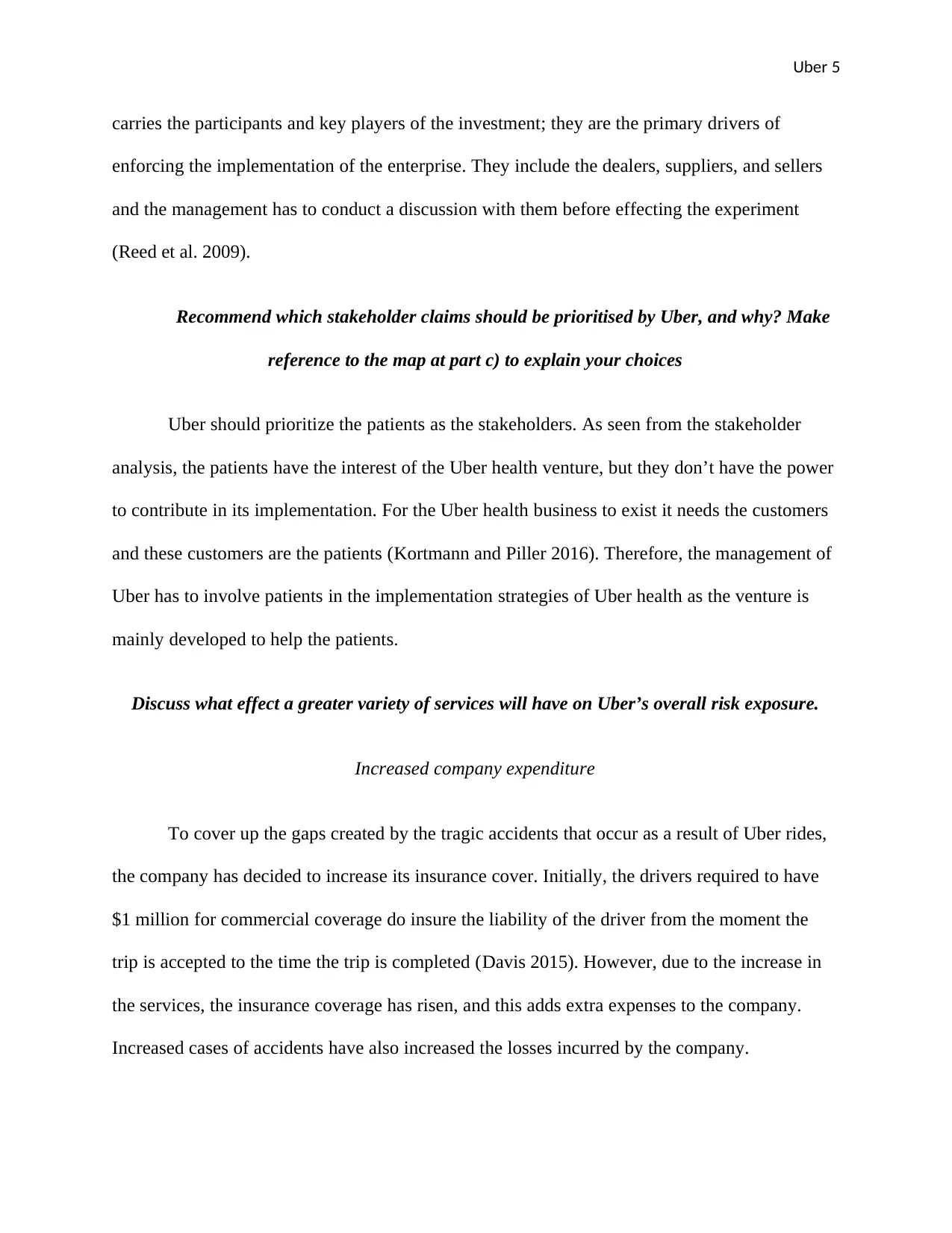
Uber 5
carries the participants and key players of the investment; they are the primary drivers of
enforcing the implementation of the enterprise. They include the dealers, suppliers, and sellers
and the management has to conduct a discussion with them before effecting the experiment
(Reed et al. 2009).
Recommend which stakeholder claims should be prioritised by Uber, and why? Make
reference to the map at part c) to explain your choices
Uber should prioritize the patients as the stakeholders. As seen from the stakeholder
analysis, the patients have the interest of the Uber health venture, but they don’t have the power
to contribute in its implementation. For the Uber health business to exist it needs the customers
and these customers are the patients (Kortmann and Piller 2016). Therefore, the management of
Uber has to involve patients in the implementation strategies of Uber health as the venture is
mainly developed to help the patients.
Discuss what effect a greater variety of services will have on Uber’s overall risk exposure.
Increased company expenditure
To cover up the gaps created by the tragic accidents that occur as a result of Uber rides,
the company has decided to increase its insurance cover. Initially, the drivers required to have
$1 million for commercial coverage do insure the liability of the driver from the moment the
trip is accepted to the time the trip is completed (Davis 2015). However, due to the increase in
the services, the insurance coverage has risen, and this adds extra expenses to the company.
Increased cases of accidents have also increased the losses incurred by the company.
carries the participants and key players of the investment; they are the primary drivers of
enforcing the implementation of the enterprise. They include the dealers, suppliers, and sellers
and the management has to conduct a discussion with them before effecting the experiment
(Reed et al. 2009).
Recommend which stakeholder claims should be prioritised by Uber, and why? Make
reference to the map at part c) to explain your choices
Uber should prioritize the patients as the stakeholders. As seen from the stakeholder
analysis, the patients have the interest of the Uber health venture, but they don’t have the power
to contribute in its implementation. For the Uber health business to exist it needs the customers
and these customers are the patients (Kortmann and Piller 2016). Therefore, the management of
Uber has to involve patients in the implementation strategies of Uber health as the venture is
mainly developed to help the patients.
Discuss what effect a greater variety of services will have on Uber’s overall risk exposure.
Increased company expenditure
To cover up the gaps created by the tragic accidents that occur as a result of Uber rides,
the company has decided to increase its insurance cover. Initially, the drivers required to have
$1 million for commercial coverage do insure the liability of the driver from the moment the
trip is accepted to the time the trip is completed (Davis 2015). However, due to the increase in
the services, the insurance coverage has risen, and this adds extra expenses to the company.
Increased cases of accidents have also increased the losses incurred by the company.
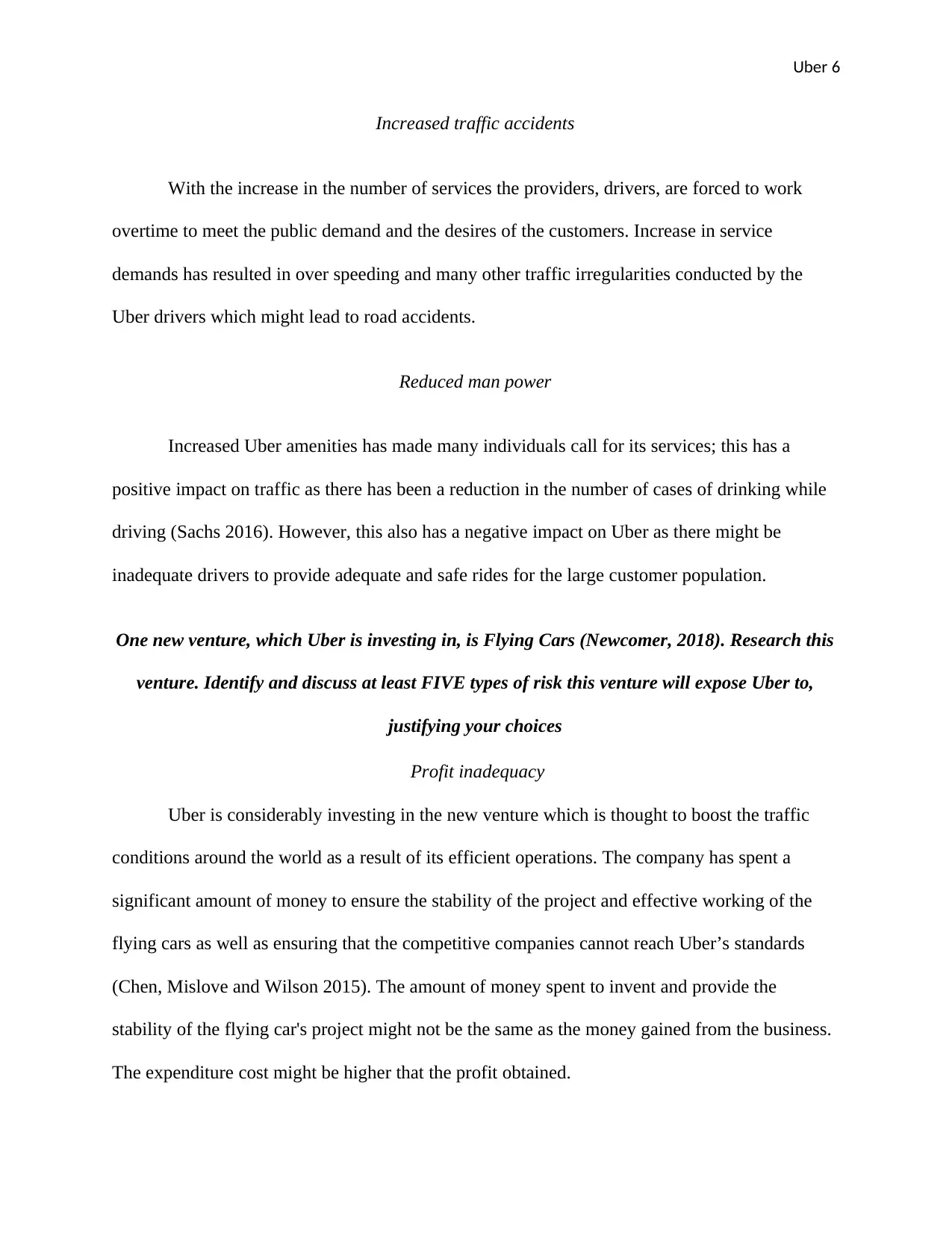
Uber 6
Increased traffic accidents
With the increase in the number of services the providers, drivers, are forced to work
overtime to meet the public demand and the desires of the customers. Increase in service
demands has resulted in over speeding and many other traffic irregularities conducted by the
Uber drivers which might lead to road accidents.
Reduced man power
Increased Uber amenities has made many individuals call for its services; this has a
positive impact on traffic as there has been a reduction in the number of cases of drinking while
driving (Sachs 2016). However, this also has a negative impact on Uber as there might be
inadequate drivers to provide adequate and safe rides for the large customer population.
One new venture, which Uber is investing in, is Flying Cars (Newcomer, 2018). Research this
venture. Identify and discuss at least FIVE types of risk this venture will expose Uber to,
justifying your choices
Profit inadequacy
Uber is considerably investing in the new venture which is thought to boost the traffic
conditions around the world as a result of its efficient operations. The company has spent a
significant amount of money to ensure the stability of the project and effective working of the
flying cars as well as ensuring that the competitive companies cannot reach Uber’s standards
(Chen, Mislove and Wilson 2015). The amount of money spent to invent and provide the
stability of the flying car's project might not be the same as the money gained from the business.
The expenditure cost might be higher that the profit obtained.
Increased traffic accidents
With the increase in the number of services the providers, drivers, are forced to work
overtime to meet the public demand and the desires of the customers. Increase in service
demands has resulted in over speeding and many other traffic irregularities conducted by the
Uber drivers which might lead to road accidents.
Reduced man power
Increased Uber amenities has made many individuals call for its services; this has a
positive impact on traffic as there has been a reduction in the number of cases of drinking while
driving (Sachs 2016). However, this also has a negative impact on Uber as there might be
inadequate drivers to provide adequate and safe rides for the large customer population.
One new venture, which Uber is investing in, is Flying Cars (Newcomer, 2018). Research this
venture. Identify and discuss at least FIVE types of risk this venture will expose Uber to,
justifying your choices
Profit inadequacy
Uber is considerably investing in the new venture which is thought to boost the traffic
conditions around the world as a result of its efficient operations. The company has spent a
significant amount of money to ensure the stability of the project and effective working of the
flying cars as well as ensuring that the competitive companies cannot reach Uber’s standards
(Chen, Mislove and Wilson 2015). The amount of money spent to invent and provide the
stability of the flying car's project might not be the same as the money gained from the business.
The expenditure cost might be higher that the profit obtained.
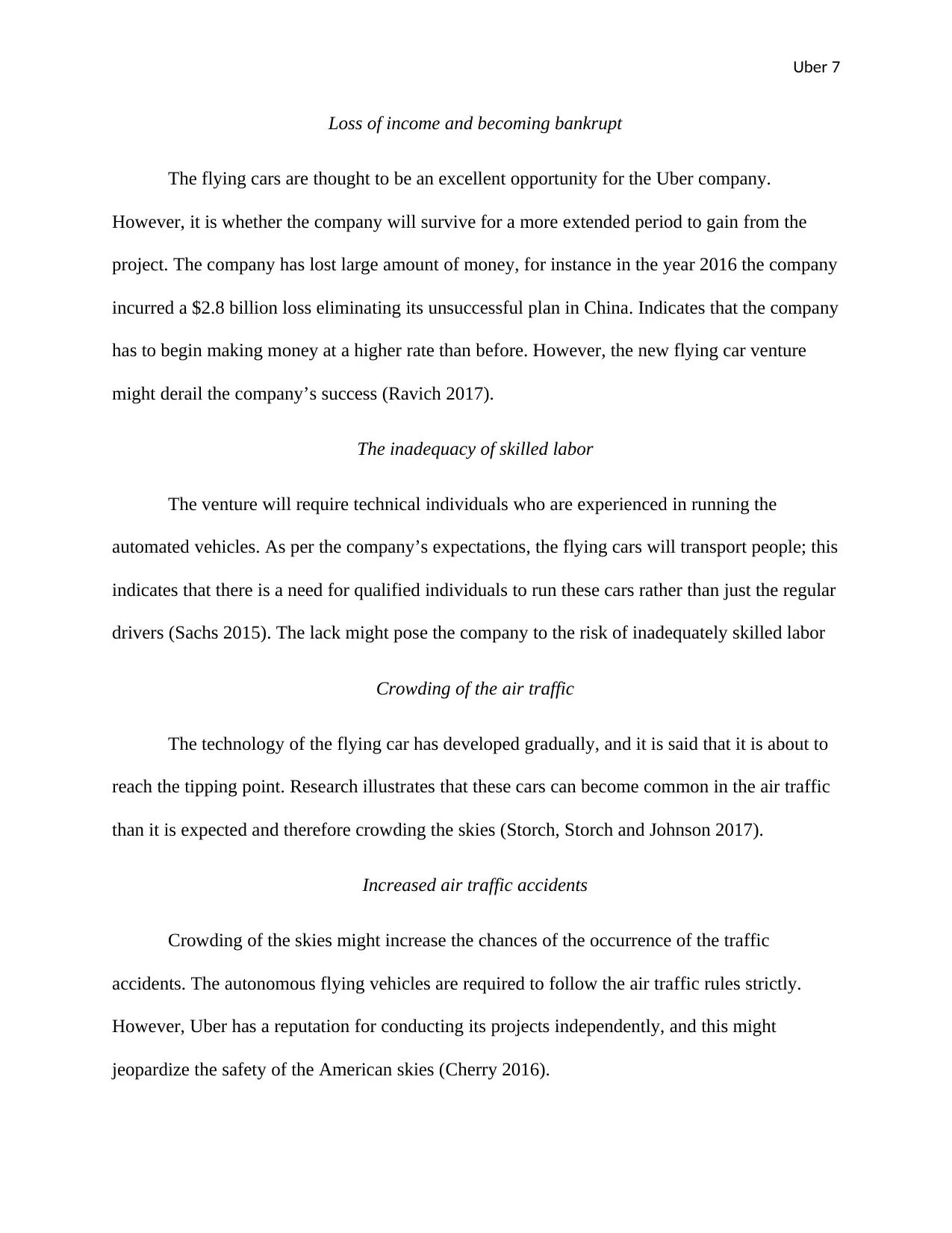
Uber 7
Loss of income and becoming bankrupt
The flying cars are thought to be an excellent opportunity for the Uber company.
However, it is whether the company will survive for a more extended period to gain from the
project. The company has lost large amount of money, for instance in the year 2016 the company
incurred a $2.8 billion loss eliminating its unsuccessful plan in China. Indicates that the company
has to begin making money at a higher rate than before. However, the new flying car venture
might derail the company’s success (Ravich 2017).
The inadequacy of skilled labor
The venture will require technical individuals who are experienced in running the
automated vehicles. As per the company’s expectations, the flying cars will transport people; this
indicates that there is a need for qualified individuals to run these cars rather than just the regular
drivers (Sachs 2015). The lack might pose the company to the risk of inadequately skilled labor
Crowding of the air traffic
The technology of the flying car has developed gradually, and it is said that it is about to
reach the tipping point. Research illustrates that these cars can become common in the air traffic
than it is expected and therefore crowding the skies (Storch, Storch and Johnson 2017).
Increased air traffic accidents
Crowding of the skies might increase the chances of the occurrence of the traffic
accidents. The autonomous flying vehicles are required to follow the air traffic rules strictly.
However, Uber has a reputation for conducting its projects independently, and this might
jeopardize the safety of the American skies (Cherry 2016).
Loss of income and becoming bankrupt
The flying cars are thought to be an excellent opportunity for the Uber company.
However, it is whether the company will survive for a more extended period to gain from the
project. The company has lost large amount of money, for instance in the year 2016 the company
incurred a $2.8 billion loss eliminating its unsuccessful plan in China. Indicates that the company
has to begin making money at a higher rate than before. However, the new flying car venture
might derail the company’s success (Ravich 2017).
The inadequacy of skilled labor
The venture will require technical individuals who are experienced in running the
automated vehicles. As per the company’s expectations, the flying cars will transport people; this
indicates that there is a need for qualified individuals to run these cars rather than just the regular
drivers (Sachs 2015). The lack might pose the company to the risk of inadequately skilled labor
Crowding of the air traffic
The technology of the flying car has developed gradually, and it is said that it is about to
reach the tipping point. Research illustrates that these cars can become common in the air traffic
than it is expected and therefore crowding the skies (Storch, Storch and Johnson 2017).
Increased air traffic accidents
Crowding of the skies might increase the chances of the occurrence of the traffic
accidents. The autonomous flying vehicles are required to follow the air traffic rules strictly.
However, Uber has a reputation for conducting its projects independently, and this might
jeopardize the safety of the American skies (Cherry 2016).
Paraphrase This Document
Need a fresh take? Get an instant paraphrase of this document with our AI Paraphraser
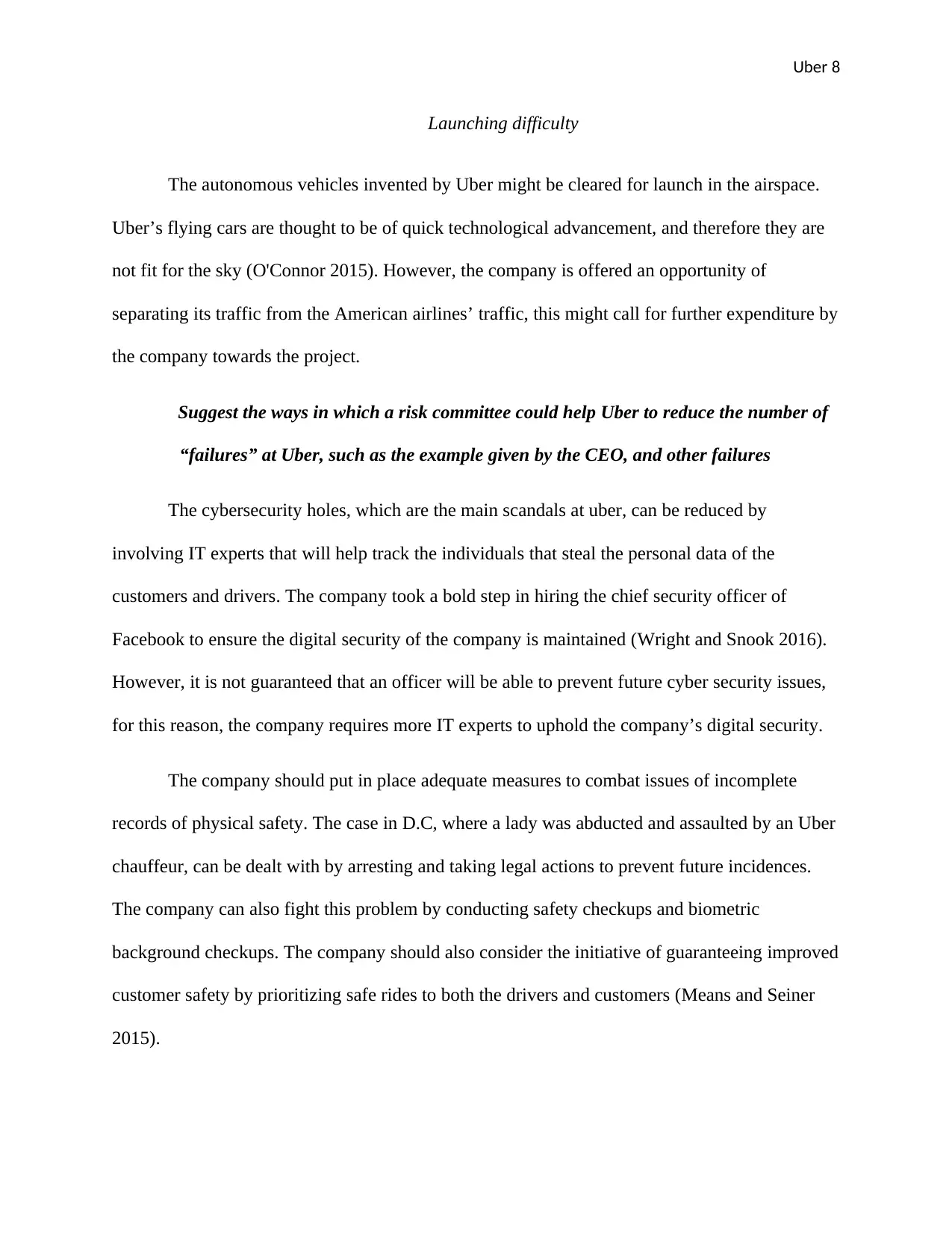
Uber 8
Launching difficulty
The autonomous vehicles invented by Uber might be cleared for launch in the airspace.
Uber’s flying cars are thought to be of quick technological advancement, and therefore they are
not fit for the sky (O'Connor 2015). However, the company is offered an opportunity of
separating its traffic from the American airlines’ traffic, this might call for further expenditure by
the company towards the project.
Suggest the ways in which a risk committee could help Uber to reduce the number of
“failures” at Uber, such as the example given by the CEO, and other failures
The cybersecurity holes, which are the main scandals at uber, can be reduced by
involving IT experts that will help track the individuals that steal the personal data of the
customers and drivers. The company took a bold step in hiring the chief security officer of
Facebook to ensure the digital security of the company is maintained (Wright and Snook 2016).
However, it is not guaranteed that an officer will be able to prevent future cyber security issues,
for this reason, the company requires more IT experts to uphold the company’s digital security.
The company should put in place adequate measures to combat issues of incomplete
records of physical safety. The case in D.C, where a lady was abducted and assaulted by an Uber
chauffeur, can be dealt with by arresting and taking legal actions to prevent future incidences.
The company can also fight this problem by conducting safety checkups and biometric
background checkups. The company should also consider the initiative of guaranteeing improved
customer safety by prioritizing safe rides to both the drivers and customers (Means and Seiner
2015).
Launching difficulty
The autonomous vehicles invented by Uber might be cleared for launch in the airspace.
Uber’s flying cars are thought to be of quick technological advancement, and therefore they are
not fit for the sky (O'Connor 2015). However, the company is offered an opportunity of
separating its traffic from the American airlines’ traffic, this might call for further expenditure by
the company towards the project.
Suggest the ways in which a risk committee could help Uber to reduce the number of
“failures” at Uber, such as the example given by the CEO, and other failures
The cybersecurity holes, which are the main scandals at uber, can be reduced by
involving IT experts that will help track the individuals that steal the personal data of the
customers and drivers. The company took a bold step in hiring the chief security officer of
Facebook to ensure the digital security of the company is maintained (Wright and Snook 2016).
However, it is not guaranteed that an officer will be able to prevent future cyber security issues,
for this reason, the company requires more IT experts to uphold the company’s digital security.
The company should put in place adequate measures to combat issues of incomplete
records of physical safety. The case in D.C, where a lady was abducted and assaulted by an Uber
chauffeur, can be dealt with by arresting and taking legal actions to prevent future incidences.
The company can also fight this problem by conducting safety checkups and biometric
background checkups. The company should also consider the initiative of guaranteeing improved
customer safety by prioritizing safe rides to both the drivers and customers (Means and Seiner
2015).
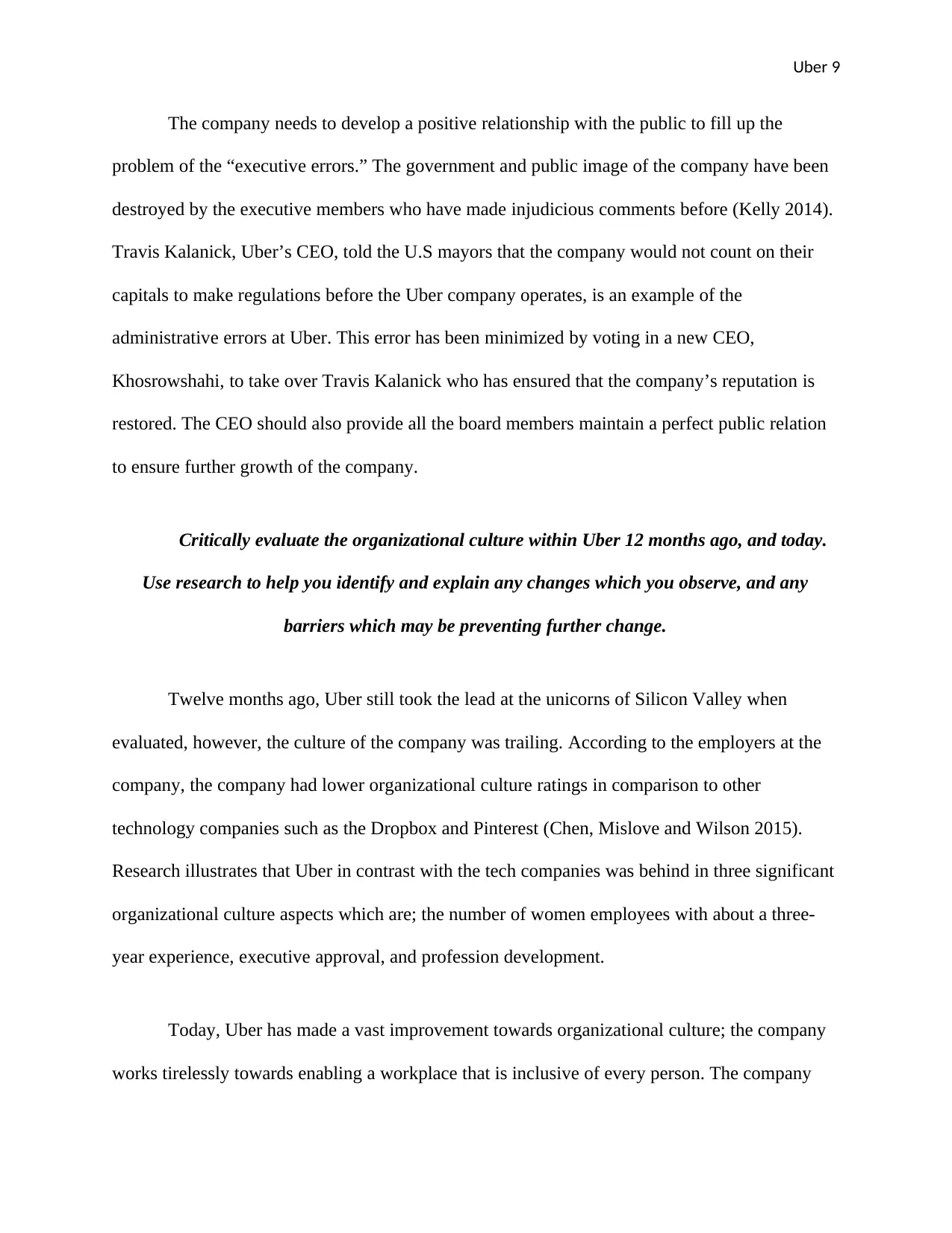
Uber 9
The company needs to develop a positive relationship with the public to fill up the
problem of the “executive errors.” The government and public image of the company have been
destroyed by the executive members who have made injudicious comments before (Kelly 2014).
Travis Kalanick, Uber’s CEO, told the U.S mayors that the company would not count on their
capitals to make regulations before the Uber company operates, is an example of the
administrative errors at Uber. This error has been minimized by voting in a new CEO,
Khosrowshahi, to take over Travis Kalanick who has ensured that the company’s reputation is
restored. The CEO should also provide all the board members maintain a perfect public relation
to ensure further growth of the company.
Critically evaluate the organizational culture within Uber 12 months ago, and today.
Use research to help you identify and explain any changes which you observe, and any
barriers which may be preventing further change.
Twelve months ago, Uber still took the lead at the unicorns of Silicon Valley when
evaluated, however, the culture of the company was trailing. According to the employers at the
company, the company had lower organizational culture ratings in comparison to other
technology companies such as the Dropbox and Pinterest (Chen, Mislove and Wilson 2015).
Research illustrates that Uber in contrast with the tech companies was behind in three significant
organizational culture aspects which are; the number of women employees with about a three-
year experience, executive approval, and profession development.
Today, Uber has made a vast improvement towards organizational culture; the company
works tirelessly towards enabling a workplace that is inclusive of every person. The company
The company needs to develop a positive relationship with the public to fill up the
problem of the “executive errors.” The government and public image of the company have been
destroyed by the executive members who have made injudicious comments before (Kelly 2014).
Travis Kalanick, Uber’s CEO, told the U.S mayors that the company would not count on their
capitals to make regulations before the Uber company operates, is an example of the
administrative errors at Uber. This error has been minimized by voting in a new CEO,
Khosrowshahi, to take over Travis Kalanick who has ensured that the company’s reputation is
restored. The CEO should also provide all the board members maintain a perfect public relation
to ensure further growth of the company.
Critically evaluate the organizational culture within Uber 12 months ago, and today.
Use research to help you identify and explain any changes which you observe, and any
barriers which may be preventing further change.
Twelve months ago, Uber still took the lead at the unicorns of Silicon Valley when
evaluated, however, the culture of the company was trailing. According to the employers at the
company, the company had lower organizational culture ratings in comparison to other
technology companies such as the Dropbox and Pinterest (Chen, Mislove and Wilson 2015).
Research illustrates that Uber in contrast with the tech companies was behind in three significant
organizational culture aspects which are; the number of women employees with about a three-
year experience, executive approval, and profession development.
Today, Uber has made a vast improvement towards organizational culture; the company
works tirelessly towards enabling a workplace that is inclusive of every person. The company
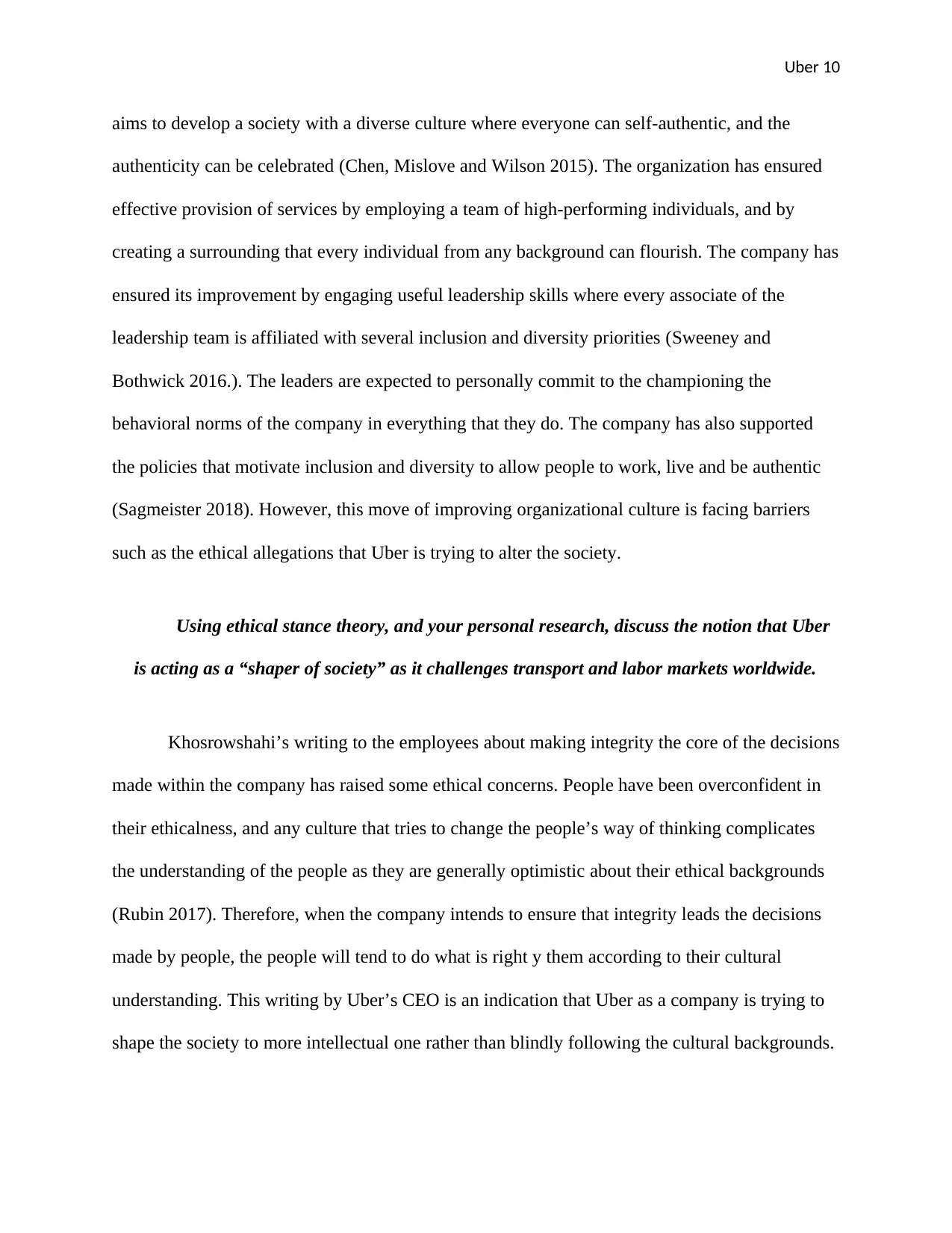
Uber 10
aims to develop a society with a diverse culture where everyone can self-authentic, and the
authenticity can be celebrated (Chen, Mislove and Wilson 2015). The organization has ensured
effective provision of services by employing a team of high-performing individuals, and by
creating a surrounding that every individual from any background can flourish. The company has
ensured its improvement by engaging useful leadership skills where every associate of the
leadership team is affiliated with several inclusion and diversity priorities (Sweeney and
Bothwick 2016.). The leaders are expected to personally commit to the championing the
behavioral norms of the company in everything that they do. The company has also supported
the policies that motivate inclusion and diversity to allow people to work, live and be authentic
(Sagmeister 2018). However, this move of improving organizational culture is facing barriers
such as the ethical allegations that Uber is trying to alter the society.
Using ethical stance theory, and your personal research, discuss the notion that Uber
is acting as a “shaper of society” as it challenges transport and labor markets worldwide.
Khosrowshahi’s writing to the employees about making integrity the core of the decisions
made within the company has raised some ethical concerns. People have been overconfident in
their ethicalness, and any culture that tries to change the people’s way of thinking complicates
the understanding of the people as they are generally optimistic about their ethical backgrounds
(Rubin 2017). Therefore, when the company intends to ensure that integrity leads the decisions
made by people, the people will tend to do what is right y them according to their cultural
understanding. This writing by Uber’s CEO is an indication that Uber as a company is trying to
shape the society to more intellectual one rather than blindly following the cultural backgrounds.
aims to develop a society with a diverse culture where everyone can self-authentic, and the
authenticity can be celebrated (Chen, Mislove and Wilson 2015). The organization has ensured
effective provision of services by employing a team of high-performing individuals, and by
creating a surrounding that every individual from any background can flourish. The company has
ensured its improvement by engaging useful leadership skills where every associate of the
leadership team is affiliated with several inclusion and diversity priorities (Sweeney and
Bothwick 2016.). The leaders are expected to personally commit to the championing the
behavioral norms of the company in everything that they do. The company has also supported
the policies that motivate inclusion and diversity to allow people to work, live and be authentic
(Sagmeister 2018). However, this move of improving organizational culture is facing barriers
such as the ethical allegations that Uber is trying to alter the society.
Using ethical stance theory, and your personal research, discuss the notion that Uber
is acting as a “shaper of society” as it challenges transport and labor markets worldwide.
Khosrowshahi’s writing to the employees about making integrity the core of the decisions
made within the company has raised some ethical concerns. People have been overconfident in
their ethicalness, and any culture that tries to change the people’s way of thinking complicates
the understanding of the people as they are generally optimistic about their ethical backgrounds
(Rubin 2017). Therefore, when the company intends to ensure that integrity leads the decisions
made by people, the people will tend to do what is right y them according to their cultural
understanding. This writing by Uber’s CEO is an indication that Uber as a company is trying to
shape the society to more intellectual one rather than blindly following the cultural backgrounds.
Secure Best Marks with AI Grader
Need help grading? Try our AI Grader for instant feedback on your assignments.
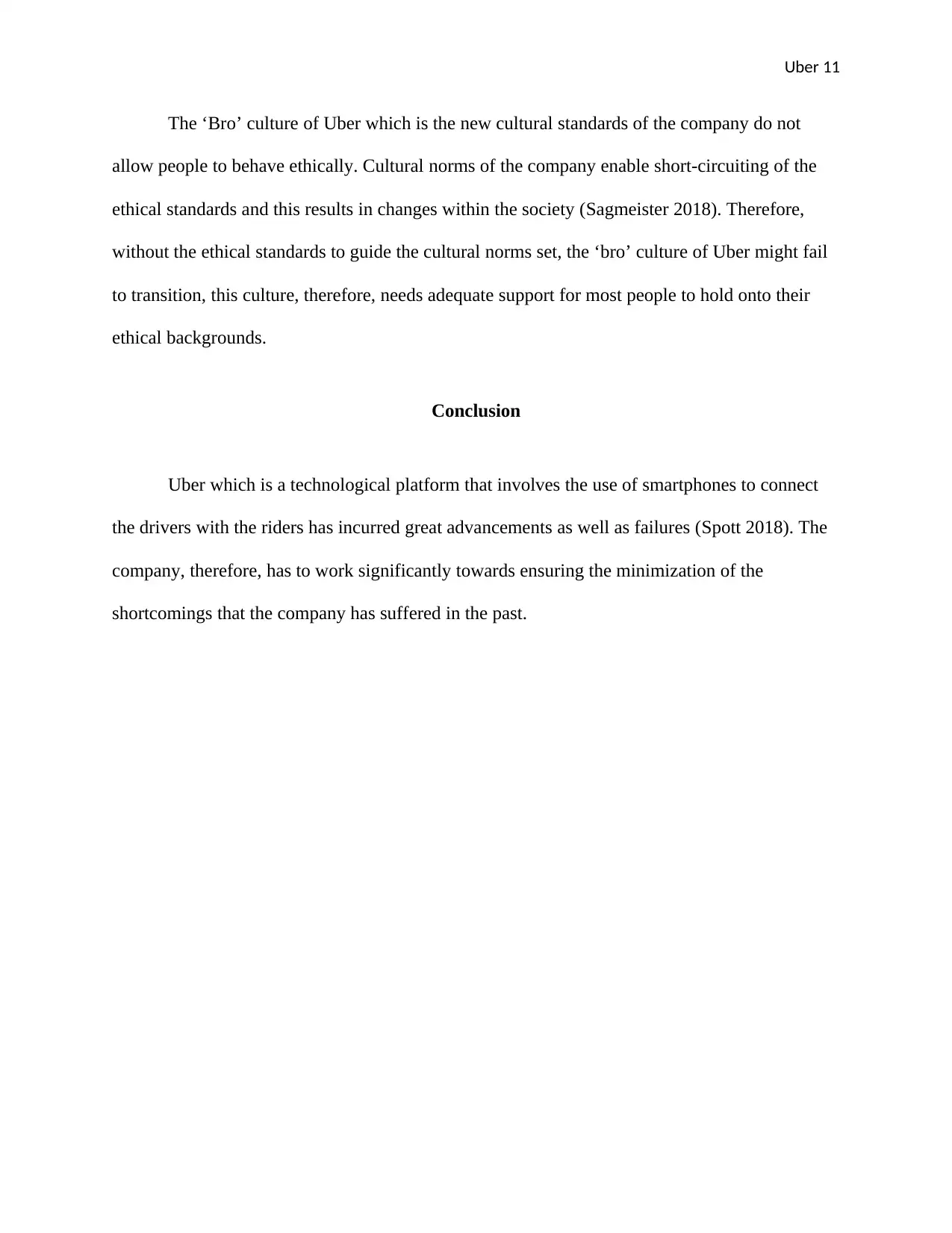
Uber 11
The ‘Bro’ culture of Uber which is the new cultural standards of the company do not
allow people to behave ethically. Cultural norms of the company enable short-circuiting of the
ethical standards and this results in changes within the society (Sagmeister 2018). Therefore,
without the ethical standards to guide the cultural norms set, the ‘bro’ culture of Uber might fail
to transition, this culture, therefore, needs adequate support for most people to hold onto their
ethical backgrounds.
Conclusion
Uber which is a technological platform that involves the use of smartphones to connect
the drivers with the riders has incurred great advancements as well as failures (Spott 2018). The
company, therefore, has to work significantly towards ensuring the minimization of the
shortcomings that the company has suffered in the past.
The ‘Bro’ culture of Uber which is the new cultural standards of the company do not
allow people to behave ethically. Cultural norms of the company enable short-circuiting of the
ethical standards and this results in changes within the society (Sagmeister 2018). Therefore,
without the ethical standards to guide the cultural norms set, the ‘bro’ culture of Uber might fail
to transition, this culture, therefore, needs adequate support for most people to hold onto their
ethical backgrounds.
Conclusion
Uber which is a technological platform that involves the use of smartphones to connect
the drivers with the riders has incurred great advancements as well as failures (Spott 2018). The
company, therefore, has to work significantly towards ensuring the minimization of the
shortcomings that the company has suffered in the past.
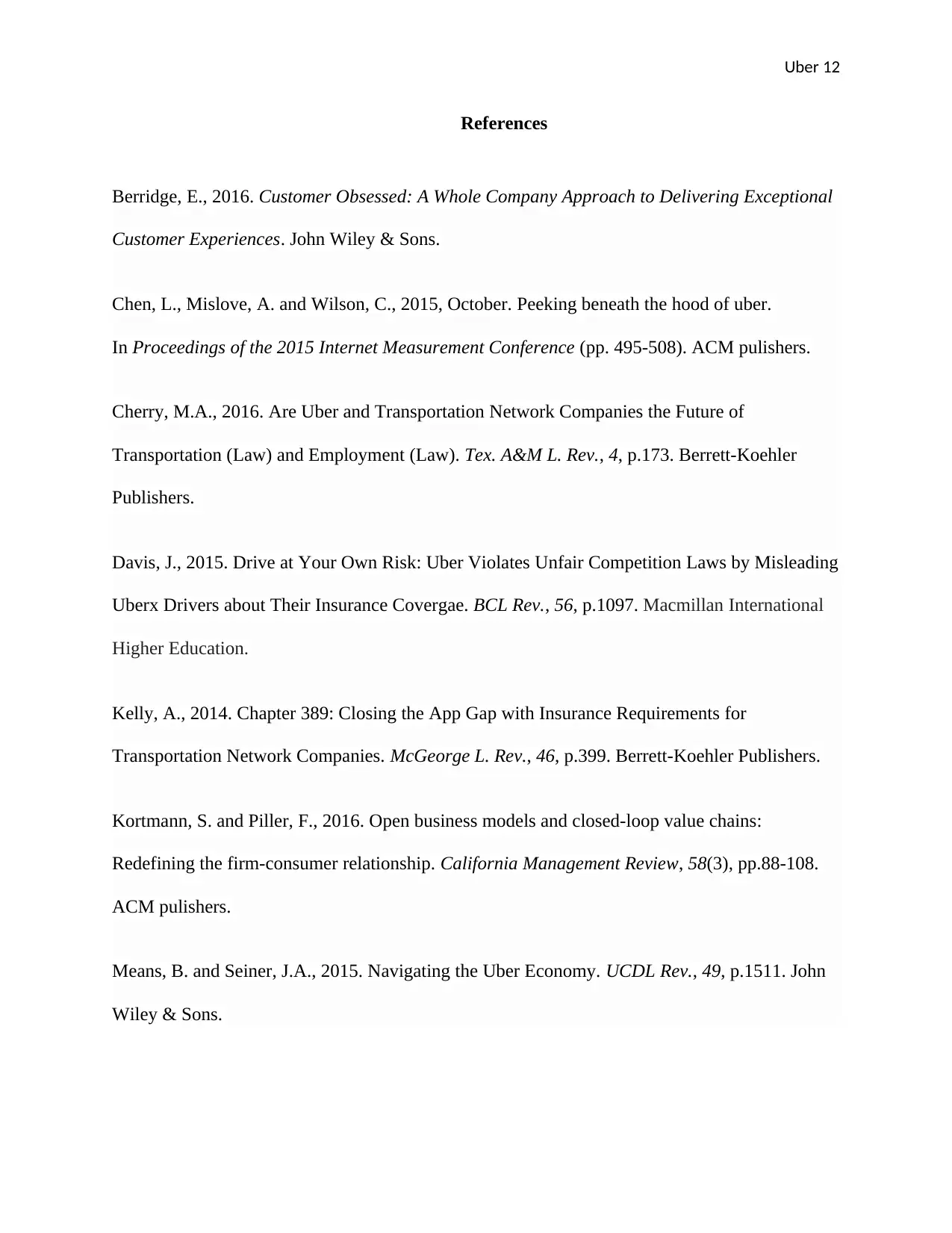
Uber 12
References
Berridge, E., 2016. Customer Obsessed: A Whole Company Approach to Delivering Exceptional
Customer Experiences. John Wiley & Sons.
Chen, L., Mislove, A. and Wilson, C., 2015, October. Peeking beneath the hood of uber.
In Proceedings of the 2015 Internet Measurement Conference (pp. 495-508). ACM pulishers.
Cherry, M.A., 2016. Are Uber and Transportation Network Companies the Future of
Transportation (Law) and Employment (Law). Tex. A&M L. Rev., 4, p.173. Berrett-Koehler
Publishers.
Davis, J., 2015. Drive at Your Own Risk: Uber Violates Unfair Competition Laws by Misleading
Uberx Drivers about Their Insurance Covergae. BCL Rev., 56, p.1097. Macmillan International
Higher Education.
Kelly, A., 2014. Chapter 389: Closing the App Gap with Insurance Requirements for
Transportation Network Companies. McGeorge L. Rev., 46, p.399. Berrett-Koehler Publishers.
Kortmann, S. and Piller, F., 2016. Open business models and closed-loop value chains:
Redefining the firm-consumer relationship. California Management Review, 58(3), pp.88-108.
ACM pulishers.
Means, B. and Seiner, J.A., 2015. Navigating the Uber Economy. UCDL Rev., 49, p.1511. John
Wiley & Sons.
References
Berridge, E., 2016. Customer Obsessed: A Whole Company Approach to Delivering Exceptional
Customer Experiences. John Wiley & Sons.
Chen, L., Mislove, A. and Wilson, C., 2015, October. Peeking beneath the hood of uber.
In Proceedings of the 2015 Internet Measurement Conference (pp. 495-508). ACM pulishers.
Cherry, M.A., 2016. Are Uber and Transportation Network Companies the Future of
Transportation (Law) and Employment (Law). Tex. A&M L. Rev., 4, p.173. Berrett-Koehler
Publishers.
Davis, J., 2015. Drive at Your Own Risk: Uber Violates Unfair Competition Laws by Misleading
Uberx Drivers about Their Insurance Covergae. BCL Rev., 56, p.1097. Macmillan International
Higher Education.
Kelly, A., 2014. Chapter 389: Closing the App Gap with Insurance Requirements for
Transportation Network Companies. McGeorge L. Rev., 46, p.399. Berrett-Koehler Publishers.
Kortmann, S. and Piller, F., 2016. Open business models and closed-loop value chains:
Redefining the firm-consumer relationship. California Management Review, 58(3), pp.88-108.
ACM pulishers.
Means, B. and Seiner, J.A., 2015. Navigating the Uber Economy. UCDL Rev., 49, p.1511. John
Wiley & Sons.
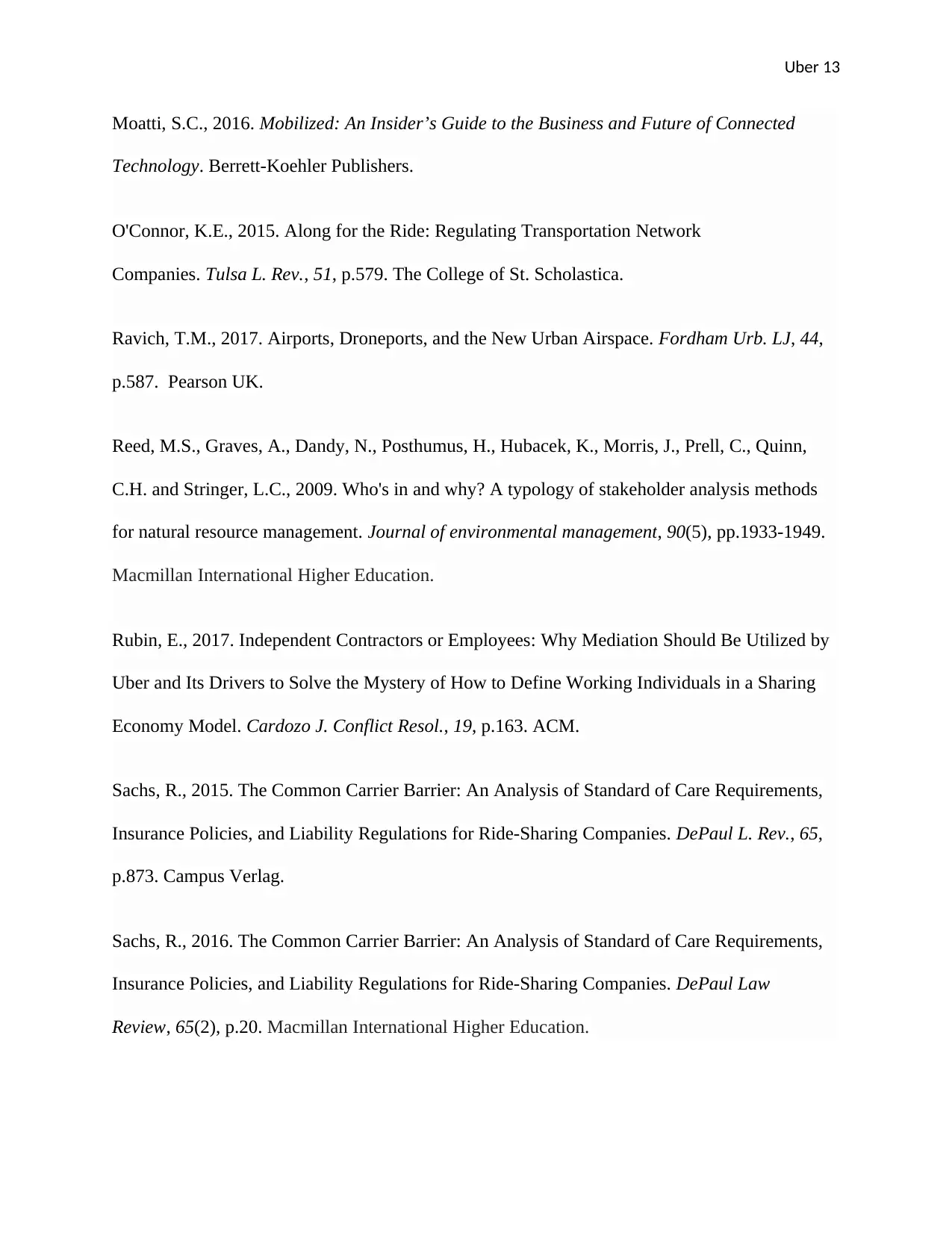
Uber 13
Moatti, S.C., 2016. Mobilized: An Insider’s Guide to the Business and Future of Connected
Technology. Berrett-Koehler Publishers.
O'Connor, K.E., 2015. Along for the Ride: Regulating Transportation Network
Companies. Tulsa L. Rev., 51, p.579. The College of St. Scholastica.
Ravich, T.M., 2017. Airports, Droneports, and the New Urban Airspace. Fordham Urb. LJ, 44,
p.587. Pearson UK.
Reed, M.S., Graves, A., Dandy, N., Posthumus, H., Hubacek, K., Morris, J., Prell, C., Quinn,
C.H. and Stringer, L.C., 2009. Who's in and why? A typology of stakeholder analysis methods
for natural resource management. Journal of environmental management, 90(5), pp.1933-1949.
Macmillan International Higher Education.
Rubin, E., 2017. Independent Contractors or Employees: Why Mediation Should Be Utilized by
Uber and Its Drivers to Solve the Mystery of How to Define Working Individuals in a Sharing
Economy Model. Cardozo J. Conflict Resol., 19, p.163. ACM.
Sachs, R., 2015. The Common Carrier Barrier: An Analysis of Standard of Care Requirements,
Insurance Policies, and Liability Regulations for Ride-Sharing Companies. DePaul L. Rev., 65,
p.873. Campus Verlag.
Sachs, R., 2016. The Common Carrier Barrier: An Analysis of Standard of Care Requirements,
Insurance Policies, and Liability Regulations for Ride-Sharing Companies. DePaul Law
Review, 65(2), p.20. Macmillan International Higher Education.
Moatti, S.C., 2016. Mobilized: An Insider’s Guide to the Business and Future of Connected
Technology. Berrett-Koehler Publishers.
O'Connor, K.E., 2015. Along for the Ride: Regulating Transportation Network
Companies. Tulsa L. Rev., 51, p.579. The College of St. Scholastica.
Ravich, T.M., 2017. Airports, Droneports, and the New Urban Airspace. Fordham Urb. LJ, 44,
p.587. Pearson UK.
Reed, M.S., Graves, A., Dandy, N., Posthumus, H., Hubacek, K., Morris, J., Prell, C., Quinn,
C.H. and Stringer, L.C., 2009. Who's in and why? A typology of stakeholder analysis methods
for natural resource management. Journal of environmental management, 90(5), pp.1933-1949.
Macmillan International Higher Education.
Rubin, E., 2017. Independent Contractors or Employees: Why Mediation Should Be Utilized by
Uber and Its Drivers to Solve the Mystery of How to Define Working Individuals in a Sharing
Economy Model. Cardozo J. Conflict Resol., 19, p.163. ACM.
Sachs, R., 2015. The Common Carrier Barrier: An Analysis of Standard of Care Requirements,
Insurance Policies, and Liability Regulations for Ride-Sharing Companies. DePaul L. Rev., 65,
p.873. Campus Verlag.
Sachs, R., 2016. The Common Carrier Barrier: An Analysis of Standard of Care Requirements,
Insurance Policies, and Liability Regulations for Ride-Sharing Companies. DePaul Law
Review, 65(2), p.20. Macmillan International Higher Education.
Paraphrase This Document
Need a fresh take? Get an instant paraphrase of this document with our AI Paraphraser
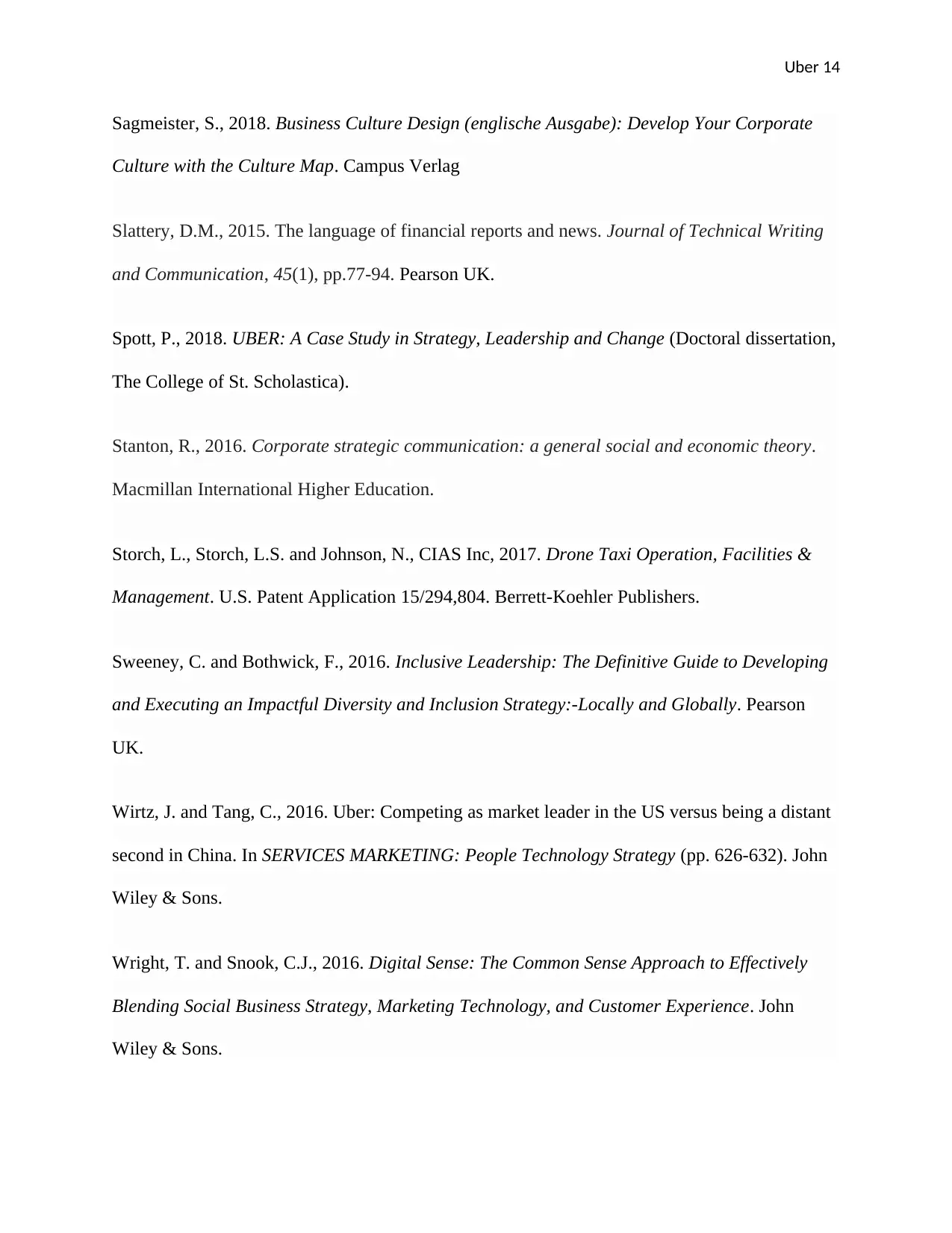
Uber 14
Sagmeister, S., 2018. Business Culture Design (englische Ausgabe): Develop Your Corporate
Culture with the Culture Map. Campus Verlag
Slattery, D.M., 2015. The language of financial reports and news. Journal of Technical Writing
and Communication, 45(1), pp.77-94. Pearson UK.
Spott, P., 2018. UBER: A Case Study in Strategy, Leadership and Change (Doctoral dissertation,
The College of St. Scholastica).
Stanton, R., 2016. Corporate strategic communication: a general social and economic theory.
Macmillan International Higher Education.
Storch, L., Storch, L.S. and Johnson, N., CIAS Inc, 2017. Drone Taxi Operation, Facilities &
Management. U.S. Patent Application 15/294,804. Berrett-Koehler Publishers.
Sweeney, C. and Bothwick, F., 2016. Inclusive Leadership: The Definitive Guide to Developing
and Executing an Impactful Diversity and Inclusion Strategy:-Locally and Globally. Pearson
UK.
Wirtz, J. and Tang, C., 2016. Uber: Competing as market leader in the US versus being a distant
second in China. In SERVICES MARKETING: People Technology Strategy (pp. 626-632). John
Wiley & Sons.
Wright, T. and Snook, C.J., 2016. Digital Sense: The Common Sense Approach to Effectively
Blending Social Business Strategy, Marketing Technology, and Customer Experience. John
Wiley & Sons.
Sagmeister, S., 2018. Business Culture Design (englische Ausgabe): Develop Your Corporate
Culture with the Culture Map. Campus Verlag
Slattery, D.M., 2015. The language of financial reports and news. Journal of Technical Writing
and Communication, 45(1), pp.77-94. Pearson UK.
Spott, P., 2018. UBER: A Case Study in Strategy, Leadership and Change (Doctoral dissertation,
The College of St. Scholastica).
Stanton, R., 2016. Corporate strategic communication: a general social and economic theory.
Macmillan International Higher Education.
Storch, L., Storch, L.S. and Johnson, N., CIAS Inc, 2017. Drone Taxi Operation, Facilities &
Management. U.S. Patent Application 15/294,804. Berrett-Koehler Publishers.
Sweeney, C. and Bothwick, F., 2016. Inclusive Leadership: The Definitive Guide to Developing
and Executing an Impactful Diversity and Inclusion Strategy:-Locally and Globally. Pearson
UK.
Wirtz, J. and Tang, C., 2016. Uber: Competing as market leader in the US versus being a distant
second in China. In SERVICES MARKETING: People Technology Strategy (pp. 626-632). John
Wiley & Sons.
Wright, T. and Snook, C.J., 2016. Digital Sense: The Common Sense Approach to Effectively
Blending Social Business Strategy, Marketing Technology, and Customer Experience. John
Wiley & Sons.
1 out of 14
Related Documents
Your All-in-One AI-Powered Toolkit for Academic Success.
+13062052269
info@desklib.com
Available 24*7 on WhatsApp / Email
![[object Object]](/_next/static/media/star-bottom.7253800d.svg)
Unlock your academic potential
© 2024 | Zucol Services PVT LTD | All rights reserved.




